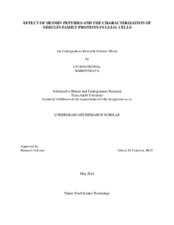| dc.description.abstract | A 3-dimensional highly integrated cytoskeletal network dynamically responds to numerous mechanical stresses faced by cells in various tissue types. Intermediate filament proteins are a major part of the cytoskeleton of cells specified in a tissue-dependent, cell-type dependent manner that play a central role in the maintenance of cellular integrity and adaptation to mechanical stress. Limited information is available in regards to the functional interplay between microtubules and intermediate filaments to maintain cellular homeostasis. Recently, it was reported that tubulin-binding intermediate filament (IF) (neurofilament NFL and vimentin) specifically killed glioma cells but not healthy astrocytes (Bouquet et. al, 2009; Berges et al. 2012). Because it is known that desmin IFs contains four binding sites predicted to bind tubulin, based on SPOT peptide arrays, that also share homology to desmin nebulin-binding peptides (Bouquet, 2009; Conover and Gregorio, 2011), we hypothesized that a conserved function of nebulin to bind IFs to stabilize actin found in myocytes could also be maintained in nerve cells. This project aims to first investigate the uptake ability of desmin peptides homologous to NFL peptides and next test their effect on the distribution of the cytoskeleton of glioma T98G cells and astrocytes. Our results show that most of the desmin peptides were internalized into glioma cells with similar efficiencies as the vimentin (58-81) peptide without causing significant apoptosis or necrosis. Surprisingly, we found that some of the desmin peptides promoted cell survival and appeared to enhance mitochondria activity. Addition of the desmin peptides did not significantly prevent tubulin polymerization assays in vitro. Moreover, immunofluorescence studies showed that the majority of the desmin peptides collapsed the microtubule networks but had little effect on the actin and vimentin cytoskeletons. Notably, we found a novel speckled nuclear staining for nebulin in glial cells, and a close association of tubulin to nebulette. Consistent with our results, the nebulin mRNA expression was recently reported in neurons and glia cells (Laitila et al, 2012), while in myocytes, nebulin and nebulette directly binds to desmin (Conover et al 2009, Dunina-Barkoskaya et al, 2014 under review). Future studies should address whether the actin-binding nebulin or nebulette proteins are capable of directly binding tubulin and further investigate their relationship to the IF cytoskeleton of nerve cells. | en |


